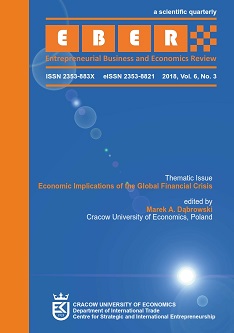Negative Interest Rate Policy in Switzerland
Negative Interest Rate Policy in Switzerland
Author(s): Elisabeth Ziegler-Hasiba, Ernesto TurnesSubject(s): National Economy, Governance, Economic policy, Economic development, Financial Markets, Fiscal Politics / Budgeting
Published by: Uniwersytet Ekonomiczny w Krakowie
Keywords: real interest rates; unconventional monetary policy; monetary transmission channels; asset price bubbles; financial stability;
Summary/Abstract: Objective: The purpose of this study is to present a review of the negative interest rate policy of the Swiss National Bank (SNB) after the outbreak of the financial crisis, in the context of falling real interest rates. Furthermore, the article demonstrates the implications of this unconventional monetary policy for the Swiss economy as well as the financial market stability. Research Design & Methods: The study is completely based on literature research. The analysis should be interpreted as being mainly suggestive since empirical research based on a quantitative analysis was not conducted. This article examines and reviews extensive arguments and evidence of 97 scientific articles. The descriptive evidence presented has a strong focus on the situation in Switzerland. Findings: In economic literature, the discussion about transmission mechanisms of the monetary policy is conducted through several channels: the interest rate channel, the ex-change rate channel and other asset price channels. In Switzerland, the impacts of the negative interest rate policy (NIRP) implemented in 2015 can so far be felt in increasing credits, especially in mortgage claims. The net income of Swiss banks from the commission and service business fell. Moreover, the exchange rate of the Swiss Franc against the Euro could be stabilised to a certain degree. Implications & Recommendations: A negative interest rate policy has an immediate impact on short-run and long-run interest rates and on banks’ interest rate margins. Currently, monetary policy is taking a turn, especially in the US. However, the leeway for higher rates in Switzerland is limited due to the interest rate differential between short-term Eurozone and Swiss money market rates. Contribution & Value Added: This article provides insights into the determinants of real interest rates and into the short-run effects of NIRP on the Swiss economy.
Journal: Entrepreneurial Business and Economics Review
- Issue Year: 6/2018
- Issue No: 3
- Page Range: 103-128
- Page Count: 26
- Language: English

